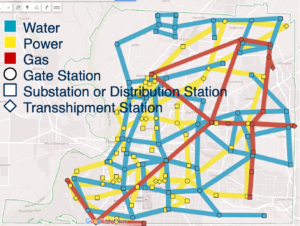Illinois National Guard pairs with CIRI to identify critical infrastructure risks
![]()
By Lauren Laws | May 10, 2024
 ‘Always Ready, Always There’. That is the motto of our nation’s National Guard. Whether it is responding to natural disasters such as tornadoes or earthquakes or to civic emergencies – the National Guard can be counted on to be on site to assist local authorities and organizations in bringing relief and recovery.
‘Always Ready, Always There’. That is the motto of our nation’s National Guard. Whether it is responding to natural disasters such as tornadoes or earthquakes or to civic emergencies – the National Guard can be counted on to be on site to assist local authorities and organizations in bringing relief and recovery.
In order to be so responsive, the National Guard must be prepared at all times. That requires planning, preparation and a solid understanding of the risks that disasters and disruptions can pose to the infrastructure and functions that keep our people safe and our societal functions operating.
The Critical Infrastructure Resilience Institute (CIRI) at the University of Illinois Urbana-Champaign is working closely with the Illinois National Guard to evaluate the use of software developed under Department of Homeland Security sponsorship and funding to support National Guard risk assessments of interconnected, interdependent critical infrastructure. Such risk assessments will help the National Guard to better plan responses to disasters.
Probabilistic Resilient Interdependent Infrastructure System Modeling, also known as PRIISM, analyzes how critical infrastructure systems are interconnected and interdependent, and how those connections impact risk.
“What we’ve found is that when we’re conducting a risk assessment of critical infrastructure, it’s critical to look beyond the single system to dependencies and interdependencies across systems to be able to get a full, comprehensive view of what the risk profile looks like for a given system or a given function,” said Dr. Iris Tien, PRIISM’s Principal Investigator and civil engineering professor at the Georgia Institute of Technology.
Created by Dr. Tien and Dr. Cynthia Lee, Georgia Tech graduate and now assistant professor at The Cooper Union, in 2019, Dr. Tien said she was first inspired to create PRIISM after a series of water system outages in Atlanta, Georgia. The outages weren’t caused by a fault in the water system. Instead, it was a power substation failure that triggered a cascade of failures to other infrastructure systems.
“That made me think this is something that’s really important to think about,” said Dr. Tien. “Even if you have the best water system, and you thought about every possibility, your assets are really well designed, and have a lot of fail safes, there are assets that are beyond your system of control that actually affect potential outages and failures.”
The team used historical outages and worked with the city of Atlanta to tune PRIISM. After presenting the tool at a series of events, Dr. Tien was approached by the Illinois National Guard to discuss how PRIISM could be used to identify infrastructure dependencies and risks for different assets in Illinois. It would be the first use case for the tool on a statewide scale. They decided to analyze Illinois’ wastewater systems first.
To conduct that analysis requires access to a variety of data sets which are being provided to the researchers by the Illinois National Guard. However, mere access to the data sets is insufficient to accomplish the analysis.
“Data sets are not always pristine,” said Dr. Tien. “When we’re looking at these systems that can be very old, the data keeping standards and practices might have been different than what they are today.”
That means cleaning them up, which takes time. Once fine-tuned, PRIISM can analyze the data sets in a matter of minutes.
“The underlying capability of PRIISM is that once all the system data is in PRIISM, you can run initial and updated analyses quickly, so if, for example, if a part of the system has failed, that information can be easily entered into PRIISM, and the information propagates through to update the full system analyses very efficiently,” said Dr. Tien.
The project is currently in its early stages and could take roughly a year. The hope is to expand beyond wastewater systems and continue to other networks. Dr. Tien said she would like to see PRIISM utilized on an even larger scale.
“One of the main things that I’ve really been pushing and advocating for with municipalities and governmental agencies is to expand how we think about infrastructure systems beyond just single-siloed systems to these large, complex, interdependent networks.”
She added it’s not only important for city and state leaders to think about, but also for people to consider in their daily lives.
“When we think about critical infrastructure, we assume that it’s going to work: you flip the switch, you’re assuming power is going to come. You turn on the faucet, you assume water is going to come, but there’s just so many interconnections behind the scenes that have to be working well and across a range of different scenarios for that to happen.”
The confidence that our critical infrastructure will operate (even if in a degraded state) through disruptions and that it will recover to full operational status quickly after the disruption is the goal and objective of CIRI and its sponsor, the Department of Homeland Security. Successful conclusion of this project will advance and support that objective.
Leave a Reply